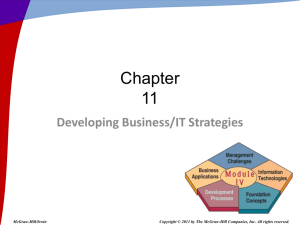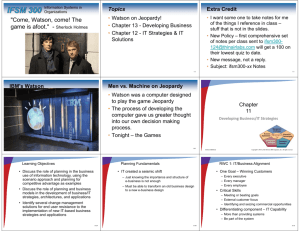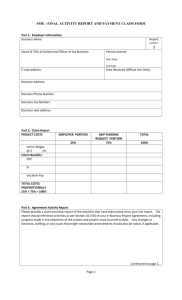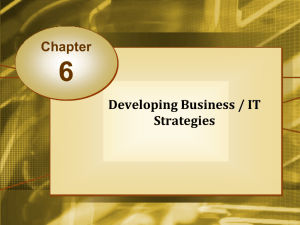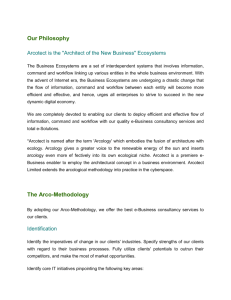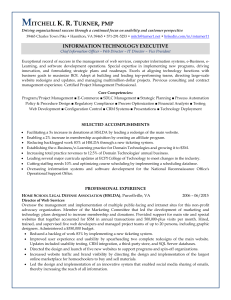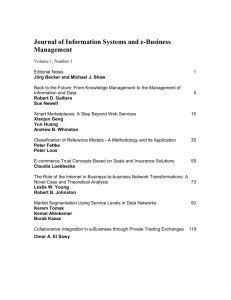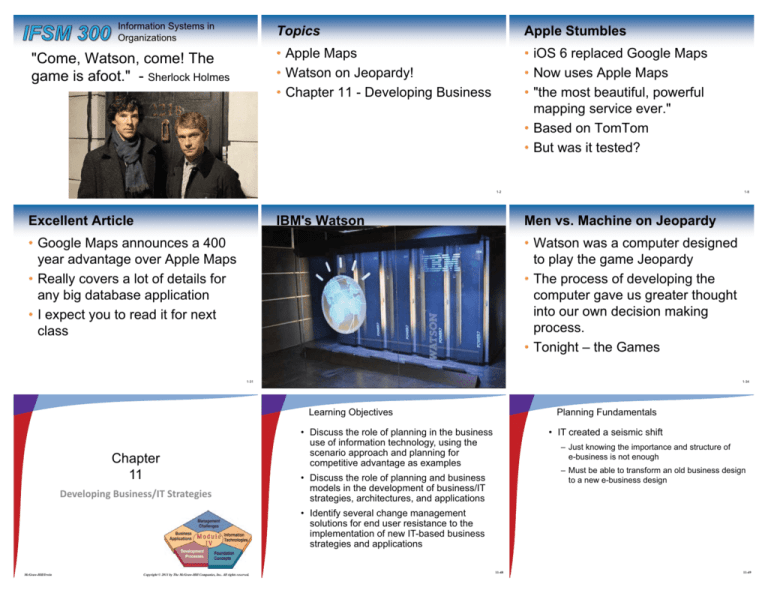
Information Systems in
Organizations
"Come, Watson, come! The
game is afoot." - Sherlock Holmes
Topics
Apple Stumbles
• Apple Maps
• Watson on Jeopardy!
• Chapter 11 - Developing Business
• iOS 6 replaced Google Maps
• Now uses Apple Maps
• "the most beautiful, powerful
mapping service ever."
• Based on TomTom
• But was it tested?
1-1
1-2
1-1
Excellent Article
1-8
1-2
IBM's Watson
1-8
Men vs. Machine on Jeopardy
• Google Maps announces a 400
year advantage over Apple Maps
• Really covers a lot of details for
any big database application
• I expect you to read it for next
class
• Watson was a computer designed
to play the game Jeopardy
• The process of developing the
computer gave us greater thought
into our own decision making
process.
• Tonight – the Games
1-31
1-33
1-31
Learning Objectives
Chapter
11
Developing Business/IT Strategies
1-34
1-33
1-34
Planning Fundamentals
• Discuss the role of planning in the business
use of information technology, using the
scenario approach and planning for
competitive advantage as examples
• IT created a seismic shift
– Just knowing the importance and structure of
e-business is not enough
– Must be able to transform an old business design
to a new e-business design
• Discuss the role of planning and business
models in the development of business/IT
strategies, architectures, and applications
• Identify several change management
solutions for end user resistance to the
implementation of new IT-based business
strategies and applications
McGraw-Hill/Irwin
Copyright © 2011 by The McGraw-Hill Companies, Inc. All rights reserved.
11-48
11-49
RWC 1: IT/Business Alignment
Components of Organizational Planning
Scenario Approach
• Gaining popularity
• One Goal – Winning Customers
– Every executive
– Every manager
– Every employee
• Less formal
• Virtual world (microworld) exercises
• Business scenarios are created and evaluated
• Critical Skills
– Meeting or beating goals
– External customer focus
– Identifying and seizing commercial opportunities
• Alternative scenarios are then created
• Differentiating component – IT Capability
– More than providing systems
– Be part of the system
11-50
Strategic Visioning Questions
11-51
Trends that Affect Strategic Planning
11-53
SWOT Analysis
Strategic Opportunities Matrix
11-54
Business Models and Planning
• Strengths
11-52
11-55
Questions for Business Models
• Vital questions
– Core competencies and resources
– Who are our customers?
• Weaknesses
– What do our customers value?
– Areas of substandard business performance
– How much will it cost to deliver that value?
• Opportunities
– How do we make money in this business?
– Potential for new business markets or innovative
breakthroughs
• Threats
– Potential for business and market losses
11-56
11-57
11-58
The Business/IT Planning Process
Information Technology Architecture
Balanced Scorecard
• Measures activities in terms of vision and
strategies
• Conceptual design components
– Technology platform
– Financial performance
– Data resources
– Impact on customers
– Application architecture
– Performance of key business processes
– IT organization
– Company’s learning curve and growth
• Four processes
– Translate vision into operational goals
– Communicate vision and link to performance
– Business planning
– Feedback/learning and strategy adjustment
11-59
Balanced Scorecard Example
11-60
11-61
Identifying Business/IT Strategies
Strategic Positioning Matrix
• Valuable Internet applications
– Transcend communication barriers
– Establish connections that enhance productivity
– Stimulate innovative development
– Improve customer relations
www.steelwedge.com
11-62
Strategic Matrix
11-63
11-64
Strategic Strategies
• Cost and Efficiency Improvements
E-Business Strategy Examples
• Global Market Penetration
– Low internal and low external connectivity
– Recommend – Use the Internet as a fast, low-cost
way to communicate and interact with others
• Performance Improvement in Effectiveness
•
•
•
•
•
•
•
– High external but low internal connectivity
– Capitalize with e-commerce websites using
value-added information services and extensive
online customer support
• Product and Service Transformation
– High internal but low external connectivity
– Recommend – Increase use intranets and
extranets
– High external and high internal connectivity
– Develop and deploy new Internet-based
products and services to create a new strategic
position in the marketplace
11-65
11-66
Market Creator
Channel Reconfiguration
Transaction Intermediary
Infomediary:
Self-Service Innovator
Supply Chain Innovator
Channel Mastery
11-67
Business Application Planning Process
Comparing Planning Approaches
11-68
Implementation Challenges
E-Business Architecture Planning
11-69
RWC 2: Project Success
Implementing Information Technology
• People skills critical to project success
• Implementation
• Developments that have generated
organizational change
– Teamwork
– Support during tough times
– Do what you planned to do
– Critical skill for managers
• Many companies are good at planning
• Few are good at executing the plan
– Even if senior management consistently identifies
e-business as an area of great opportunity and
critical need
11-70
–
–
–
–
–
–
–
–
• Bad relationships leading cause of failure
• Managers tend to go to software instead of
building relations
• Showing progress at short intervals helps
Business process reengineering
ERP systems
Y2K compliance
Shared service centers
Just-in-time manufacturing
Sales force automation
Contract manufacturing
Introduction of Euro currency
• E-business is the latest catalyst
11-71
Impact and Scope of Implementing IT
11-72
Impact and Scope of Implementing IT
11-73
End User Resistance and Involvement
• Change generates resistance
• Examples:
– Customer Relationship Management (CRM)
– Knowledge Management Systems (KM)
• CRM failures
– CRM failure rate up to 75 percent
– Causes for failure
• Sales force automation problems
• Unaddressed cultural issues
11-74
11-75
• Sales staffs fearful and thus resistant
11-76
Obstacles to KM Systems
Keys to Solving End User Resistance
Key Dimensions of Change Management
• Create relationships
– Understand the end-user’s situation
• Provide education and training
• Require involvement and commitment
– End-users
– Top management
– All stakeholders
• Eliminate frustration and inconvenience
11-77
Change Management Programs
11-78
Change Management Tactics
• Develop a change action plan
11-79
A Change Management Process
• Involve as many people as possible in ebusiness planning and application
development
• Assign managers as change sponsors
• Develop employee change teams
• Make constant change an expected part of
the culture
• Encourage open communications and
feedback about organizational changes
• Tell everyone as much as possible about
everything, as often as possible, in person
• Make liberal use of financial incentives and
recognition
• Work within company culture, not around it
11-80
11-81
RWC 3: Crucial Strategic Planning Elements
Avnet Marshall’s Transformation
RWC 4: The Science behind Change
• Implementing changes is very challenging
• Employees resist change
• Understanding can lead to smoother
transitions
• Not everyone is motivated by ambition
• Education and training aid with acceptance
• Alignment between business and IT
– IT strategic plan to improve the business-IT
relationship
– Articulate how IT fits into business and overall
business strategy.
• Apply clear strategy to business activities
11-83
11-82
11-84
11-85

